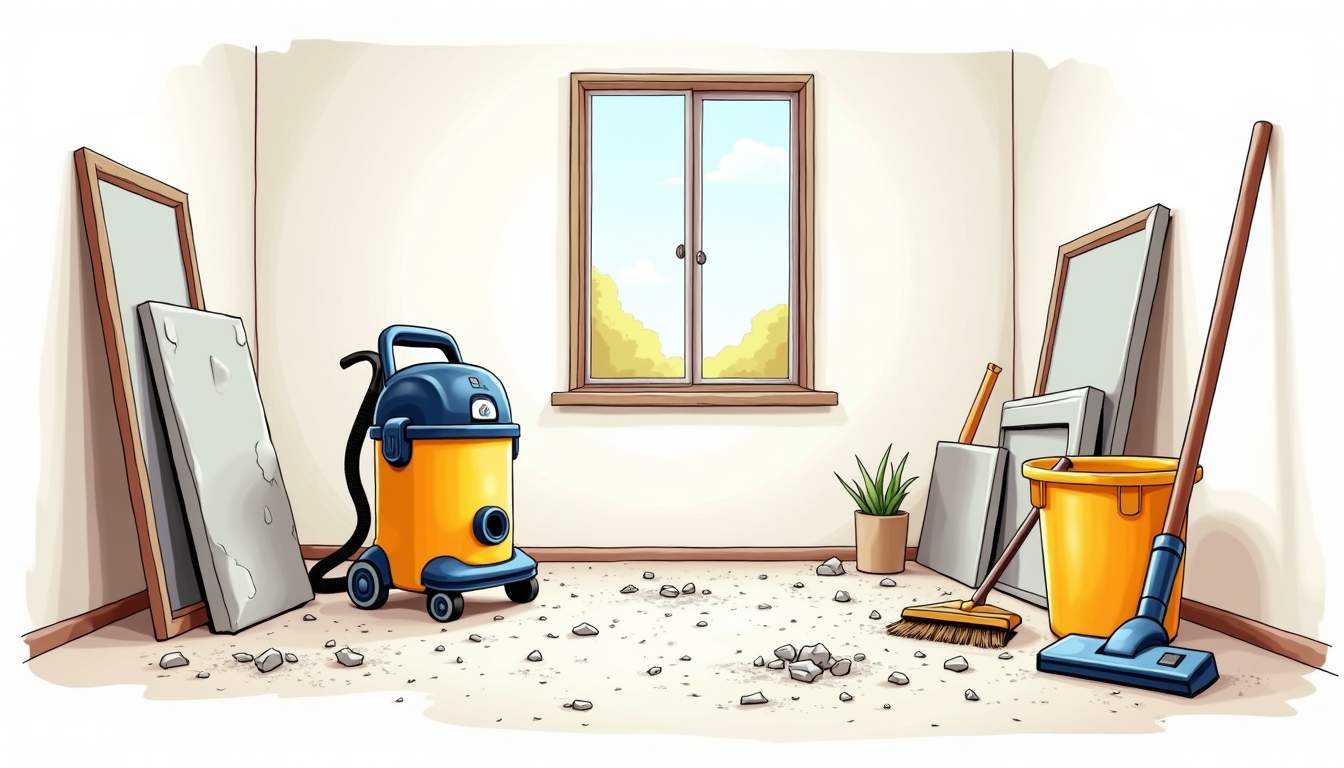There’s a unique kind of chaos that follows a construction project. Walls are up, floors are laid, but the space looks more like a dust bowl than a finished room. That’s where post-construction cleaning steps in-transforming the mess into a livable, sparkling environment. It’s not just about sweeping up; it’s a detailed process that requires the right tools, techniques, and know-how to tackle every speck of dust and debris left behind.
Why Post-Construction Cleaning Is Different
Cleaning a home or office after construction isn’t like your regular weekly tidy-up. It’s a whole new level of dirt and debris. Construction dust is fine, stubborn, and can settle into every nook and cranny. Plus, leftover materials like drywall dust, paint splatters, wood shavings, and even tiny nails or screws can pose hazards if not properly removed.
This type of cleaning demands specialized equipment and methods. A regular vacuum cleaner won’t cut it. Instead, industrial-grade vacuums with HEPA filters are needed to capture the microscopic dust particles that can linger in the air and cause respiratory issues. Plus, surfaces often need to be wiped down multiple times to remove layers of dust that settle after initial cleaning.
The Health Factor
Construction dust isn’t just unsightly; it can affect your health. Breathing in fine dust can irritate the lungs and aggravate allergies or asthma. That’s why thorough cleaning is essential before anyone moves into the space. Without it, dust can continue to circulate, causing discomfort and even long-term health problems.
Moreover, the presence of volatile organic compounds (VOCs) in leftover paints and adhesives can further complicate the air quality. These compounds can off-gas for weeks or even months after construction is complete, leading to headaches, dizziness, and other health issues. Therefore, post-construction cleaning not only involves physical removal of debris but also requires ensuring that the environment is safe and healthy for occupants. Professional cleaners often employ air scrubbers and dehumidifiers to help mitigate these risks, ensuring that the space is not just clean, but also conducive to good health.
Additionally, the scope of post-construction cleaning can vary significantly depending on the scale of the project. A small renovation may require a straightforward clean-up, while a large commercial build might necessitate a multi-phase approach, including deep cleaning of carpets, windows, and even HVAC systems. Each stage of cleaning is crucial, as it helps to eliminate the remnants of construction that can linger and affect the overall aesthetic and comfort of the space. This comprehensive approach ensures that every corner is addressed, allowing for a fresh start in a newly constructed environment. For professional services, visit RMS Cleaning through the following link: https://rms-cleaning.com/
Step-by-Step Guide to Post-Construction Cleaning
Getting from a dusty construction site to a pristine, ready-to-use space requires a systematic approach. Here’s a breakdown of the key steps involved.

1. Remove Large Debris
The first step is clearing out the big stuff. This means picking up leftover nails, screws, wood scraps, packaging materials, and any trash left behind by contractors. It’s important to wear gloves and sturdy shoes during this phase to avoid injury.
Discarding these materials properly sets the stage for more detailed cleaning and ensures safety for the cleaning crew. Additionally, consider sorting recyclable materials from regular trash, as many construction materials can be repurposed or recycled. This not only helps in reducing waste but also promotes eco-friendly practices in construction projects.
2. Dusting and Vacuuming
Once the large debris is gone, it’s time to tackle the dust. Start with dry dusting surfaces like window sills, baseboards, shelves, and ledges. Using microfiber cloths helps trap dust instead of just moving it around.
After dusting, vacuum all floors, carpets, and upholstery with a vacuum equipped with a HEPA filter. This captures the fine dust particles that ordinary vacuums might miss. Don’t forget to vacuum vents and air ducts where dust can accumulate. Pay special attention to corners and crevices, as these areas often harbor hidden dust bunnies and construction residues that can affect air quality and overall cleanliness.
3. Wet Cleaning Surfaces
Dry dusting and vacuuming only get you so far. Next up is wet cleaning. Wipe down all surfaces with a damp cloth and appropriate cleaning solutions. Walls, doors, cabinets, countertops, and windows all need attention. Sometimes multiple passes are necessary to remove stubborn dust layers.
Be mindful of the materials you’re cleaning; for example, wood surfaces require gentle cleaners, while tiles and glass can handle stronger solutions. For windows, using a squeegee can help achieve a streak-free finish, allowing natural light to flood the space and highlight the fresh, clean environment. Remember to also clean any fixtures or fittings that may have collected dust during the construction process, ensuring that every detail is attended to.
4. Floor Care
Floors often take the brunt of construction mess. Whether it’s hardwood, tile, laminate, or carpet, each floor type needs a specific cleaning method. Hardwood floors should be swept and then mopped with a cleaner designed for wood. Tiles benefit from scrubbing and rinsing, while carpets might require deep steam cleaning to remove dust and residues embedded in the fibers.
For laminate floors, a damp mop with a gentle cleaner can help maintain their shine without causing damage. It’s also wise to check for any scratches or scuffs that may have occurred during construction, as these can be addressed with specialized products designed to restore the floor’s finish. Ensuring that your floors are not only clean but also well-maintained will enhance the overall aesthetic of the space.
5. Final Touches
After the heavy cleaning, it’s time for the finishing touches. Clean light fixtures, switch plates, door handles, and any other hardware. Replace air filters in HVAC systems to ensure clean air circulation. Check for any missed spots and give them a final wipe down.
Additionally, consider adding a pleasant scent to the space, as fresh air can sometimes carry a lingering construction odor. Using air fresheners or natural options like essential oils can create a welcoming atmosphere. Finally, inspect the area for any last-minute adjustments or repairs needed, ensuring that every aspect of the newly constructed space is perfect and ready for its intended use.
Tools and Products That Make a Difference
Having the right tools can turn a daunting cleaning job into a manageable one. Here are some essentials for post-construction cleaning:
HEPA Vacuum Cleaner
A vacuum with a HEPA filter is crucial. It traps tiny dust particles that regular vacuums blow back into the air. This keeps the environment healthier and cleaner.
Microfiber Cloths and Mops
Microfiber materials attract and hold dust better than traditional cloths. They’re great for dusting surfaces and wet cleaning floors without scratching.
Scrapers and Putty Knives
These tools help remove paint splatters, dried adhesives, or other stuck-on debris without damaging surfaces.
All-Purpose and Specialty Cleaners
Choose cleaners based on the surfaces you’re tackling. Wood polish, glass cleaner, tile grout cleaner, and gentle detergents all have their place.
Protective Gear
Dust masks, gloves, and safety goggles protect the cleaner from irritants and potential hazards on the site.
Hiring Professionals vs. DIY
Some homeowners and business owners consider tackling post-construction cleaning themselves. While it’s possible, there are pros and cons to weigh.
Why Hire Professionals?
Professional cleaners bring experience, specialized equipment, and efficiency. They know where dust hides and how to remove it thoroughly. For large projects or commercial spaces, hiring a team can save time and ensure the job is done right.
Additionally, professionals often offer insurance and guarantees, providing peace of mind that the cleaning meets high standards.
When DIY Makes Sense
For smaller projects or tight budgets, doing it yourself can work. Just be prepared to invest time and effort. Make sure to rent or buy the right equipment, and don’t rush the process. Taking shortcuts can leave dust behind and compromise the space’s cleanliness.
Common Challenges and How to Overcome Them
Post-construction cleaning isn’t without its hurdles. Here are some typical issues and tips to handle them.
Stubborn Dust Layers
Sometimes dust settles in thick layers that resist initial cleaning. Multiple rounds of dusting and wiping may be necessary. Using slightly damp microfiber cloths helps trap dust better than dry ones. Patience is key.
Paint and Adhesive Residue
Dried paint spots and sticky adhesives can be tough to remove. Use plastic scrapers or putty knives carefully to avoid surface damage. For paint, specialized removers might be needed, but always test on a small area first.
Dirty Air Vents and Filters
Construction dust often infiltrates HVAC systems. Change or clean air filters promptly, and consider professional duct cleaning if dust buildup is heavy. This improves air quality and prevents dust from recirculating.
Delicate Surfaces
Some materials-like natural stone, hardwood, or specialty finishes-require gentle cleaning products. Always check manufacturer recommendations to avoid damage. When in doubt, test cleaners on an inconspicuous spot.
Maintaining Cleanliness After Construction
Once the post-construction cleaning is done, it’s important to keep the space clean and dust-free. Here are some tips to maintain the results:

- Regular Dusting: Use microfiber cloths to dust surfaces weekly to prevent buildup.
- Frequent Vacuuming: Vacuum floors and upholstery regularly, especially if the area is high-traffic.
- Air Quality Control: Replace HVAC filters every few months and consider using air purifiers.
- Spot Cleaning: Address spills and dirt immediately to avoid stains and buildup.
- Limit Foot Traffic: Use mats at entrances to reduce dirt tracked inside.
Maintaining a clean environment after construction not only keeps the space looking great but also protects your investment and health.
Final Thoughts
Post-construction cleaning is the bridge between a construction site and a finished, functional space. It demands attention to detail, the right tools, and a clear plan. Whether you choose to hire professionals or roll up your sleeves yourself, understanding the process helps ensure the job gets done thoroughly.

Remember, the goal is more than just removing visible dust-it’s about creating a safe, healthy, and welcoming environment where people can live, work, and thrive. From dust to done, the transformation is worth every effort.